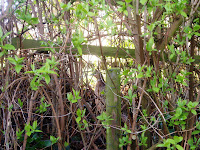 Handsome fellow isn't he! Photo 1 shows one of two male Common Pheasants (Phasianus colchicus) that visited my garden recently. Living as I do in rural Oxfordshire, meeting one isn't unusual; their rearing and shooting is common hereabouts.
Handsome fellow isn't he! Photo 1 shows one of two male Common Pheasants (Phasianus colchicus) that visited my garden recently. Living as I do in rural Oxfordshire, meeting one isn't unusual; their rearing and shooting is common hereabouts.The RSPB estimates there are 1.8million breeding female pheasants in the UK.
From a search of the internet a few random facts I've turned up about pheasants include some evidence that pheasants are sensitive to noises beyond the range of human hearing (Stewart, The Ohio Journal of Science. v55 n2 (March, 1955), 122-125). Secondly, given a choice, the 'stuff' (sand, loam, straw, feathers...) in which an adult pheasant will choose to take a dustbath can be predicted ahead of time by noting the material a bird prefers to peck at when still a chick (Vestergaard&Bildsoe, B Acta Vet. Brno, 1999,68, p141). This may seem an esoteric piece of knowledge, but as anyone who has ever watched a documentary about battery chickens will know, feather plucking is a damaging problem among livestock birds under confined conditions and an understanding of pecking behavior in birds can have worthwhile commercial implications.
 The Common Pheasant is native to Asia. Like the peacocks, the Common Pheasant is an example of a sexually dimorphic species - a species in which males and females show consistent difference in form. Male pheasants are brightly coloured; Females are cryptically camouflaged. Photo 2 shows a female I spotted lurking in my garden shrubbery early last summer.
The Common Pheasant is native to Asia. Like the peacocks, the Common Pheasant is an example of a sexually dimorphic species - a species in which males and females show consistent difference in form. Male pheasants are brightly coloured; Females are cryptically camouflaged. Photo 2 shows a female I spotted lurking in my garden shrubbery early last summer.Sexual dimorphism is a much studied topic in the theory of evolution. Scientists would like to understand more deeply what forces encourage it and what advantages follow.
An internet search led me to a number of papers on sexual dimorphism in pheasants but unfortunately most were on the pay-to-view sites of commercial publishing firms. This always irritates me as it's typically you and I, the taxpayer, that has paid for the research contained in these papers. To be asked to pay again to read the results seems a bit much! Anyway, I did manage to find a few freely available papers from which I learn that female pheasants choose male mates based, in part, on the length of their spurs. Studies have shown spur length to be an honest indicator (see my peacock posting) of male health - males with longer spurs really do seem to be fitter than less well endowed males.
Spurs are a secondary sexual characteristic - a characteristic that differs between the sexes.
Girl pheasants also appear to judge their men folk according to the quality of their wattles (the red cheek patches in photo 1). Smith et.al. provide one study of this. My (amateur) understanding of their work is as follows:
Biologists had previously worked out that certain 'carotinoid' chemicals were associated with coloured appendages in some animals. At the same time, animals getting a good diet were known (perhaps unsurprisingly!) to have stronger immune systems than poorly nourished specimens. Smith et.al. wondered whether carotinoids were the root cause of both i.e. whether both the strength of a male's disease immunity and their wattle quality were directly controlled by the amount of carotinoids in their diet. If so, this might provide a very natural explanation of why females have 'a thing' for wattles -good wattles would be an honest indicator of the disease resistance of a suitor.
And the answer...after a series of detailed experiments Smith et.al. found no such correlation! Back to the drawing board in terms of discovering the deeper explanation of what's going on, but a nice example for those who might question whether science isn't ultimately a process of rigorous enquiry.
1 comment:
Of course, as with so many other topics in biology, when it comes to sexual selection, Darwin got there first. See: The Descent of Man, and Selection in Relation to Sex, where he writes at length about pheasants.
Post a Comment